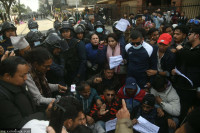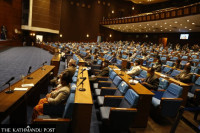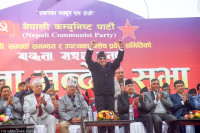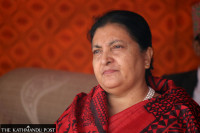Politics
Provinces are in an ‘ugly competition’ to appoint more ministers
Experts say more ministries means increased administrative expenses at the cost of development activities, and call for constitutional curbs.
Binod Ghimire
Chief Minister of Bagmati Province Rajendra Pandey has bifurcated three ministries in the last two months since forming government on October 28.
The province had eight ministries when he succeeded Asta Laxmi Shakya of the CPN-UML. However, now the largest province in terms of provincial assembly members has 14 ministries and 18 ministers. Before a split in the Nepal Communist Party (NCP) and subsequently in the CPN-UML, all seven provinces had seven ministers each. However, with the formation of the five-party alliance, which toppled the UML governments in provinces, there is competition among the provincial governments to add the numbers of ministries and ministers.
The chief ministers have found bifurcating ministries as an easy way to accommodate more of their ministerial aspirant party leaders in the government. Barring Province 1 and Sudur Paschim Province, all other provincial governments have bifurcated ministries adding extra burden to state coffers. Though Trilochan Bhatta, chief minister of Sudur Paschim Province, has not split ministries, his Cabinet has 11 ministers including four state ministers, which is in breach of the constitution.
The Constitution of Nepal allows a provincial council of ministers to have up to 20 percent of the total provincial assembly members. Article 167 (2) of the statute says the chief of the province shall, on the chief minister’s recommendation, constitute the Provincial Council of Ministers consisting of a maximum 20 percent of the total number of assembly members, including the chief minister, in line with the principle of inclusion, from amongst the assembly members.
The Sudur Paschim Provincial Assembly has 53-members at present. As per the constitution, the maximum number of ministers the province can have is 10 as 20 percent of 53 stands at 10.6. However, the province has 11 ministers. Rajendra Rai, chief minister from Province 1, is leading the government with four ministers and a state minister. However, he is in the process of splitting several ministries to accommodate provincial assembly members from the Nepali Congress, CPN (Maoist Centre) and Janata Samajabadi Party in the government.
Out of the seven provinces, the Congress, the Maoist Centre and the CPN (Unified Socialist) lead two each while the Janata Samajbadi Party heads Province 2. The leaders from the ruling parties claim expansion of the cabinet shouldn’t be taken as otherwise as long as they are within the constitutional ceiling. “The provincial governments can be up to 20 percent of the provincial assembly members. I don’t think Bagmati or other provinces have exceeded the limit,” Bedu Ram Bhusal, general secretary of the Unified Socialist, told the Post. “The Bagmati Province still can add four more ministers.”
The Bagmati Provincial Assembly has 120 members which means Pandey can have 24 ministers at maximum. Likewise, the Gandaki provincial assembly has 60 members, which means the provincial council of ministers can have 12 members at most. The province already has 12 ministers. The number of ministers in Province 2 has reached 13 in the last four months.
The Lumbini Province has 17 ministers at present. Chief Minister Kul Prasad KC has inducted the maximum number of the ministers allowed by the constitution. The Lumbini Provincial Assembly has 82 members at present as five seats remain vacant. Experts on administrative affairs say it was Shankar Pokhrel from Lumbini Province who started the practice of splitting ministers. In an attempt to save his government, Pokharel had split two ministries to accommodate leaders of the then Janata Samajbadi Party in the government.
“Pokhrel started the wrong practice. The present governments have taken it to the next level,” Kashi Raj Dahal, former chairperson of the Administrative Court, told the Post. “The ugly competition continues.”
The Dahal-led Federalism Recommendation Committee had recommended in December 2014 that provincial governments shouldn’t have more than seven ministries. Until the change in the recent political dynamics, most of the provinces had seven ministries. Dahal says all the provincial governments functioned with seven ministries for over three years proving that their recommendation was practical.
Those who were part of the constitution drafting committee say they had mentioned that the size of the provincial council of ministers would be 10 percent of the members of the provincial assembly. Rewati Raman Bhandari, a member of the committee in the Constituent Assembly, says the percentage was doubled without proper consultation. He says the numbers of ministers have increased by 50 percent in the last four-five months. Currently, there are 90 ministers in the seven provinces where the total strength of the provincial assembly members is 550. There were 50 ministers until the change in the political dynamics started with a split in the NCP (NCP).
“The 20 percent is a maximum limit but all the provinces are close to the limit,” said Bhandari. He claimed some of the ministers have been formed just for the sake of accommodating politicians in the government. The authority for education and health, as per the constitution, lies either with the federal or the local governments, however, Bagmati Province for instance has separate ministries for education and health.
The experts say more ministries means increased administrative expenses at the cost of development activities. “Increase in the administrative cost means the development budget will be hit. This is not why we needed federalism,” Dahal said. “Let’s amend the constitution and laws to ensure the numbers of ministers don’t go beyond seven.”




 19.12°C Kathmandu
19.12°C Kathmandu















